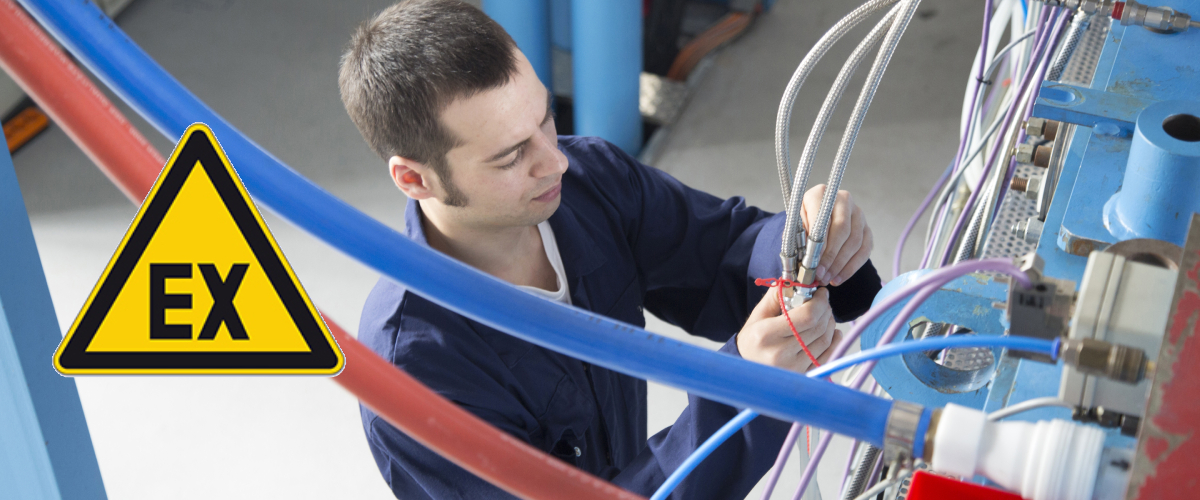Home » What is ATEX? The European directive for explosive environments » ATEX guidelines
ATEX guidelines
- Publicatie datum May 22, 2023
- Auteur Joost van Hulst
- Laatst aangepast May 22, 2023
 800
800 Explosive environments pose a serious threat to workers in various industries, such as the petrochemical, food and pharmaceutical industries.
To guarantee the safety of employees and to minimize the risk of explosions, the ATEX guidelines have been created. We will explain exactly what the ATEX guidelines are, what they entail and what their importance is.
What are ATEX directives?
ATEX (ATmosphères EXplosibles) directives are a series of European directives that prescribe specific requirements and measures for companies that work in potentially explosive atmospheres. These guidelines are intended to ensure worker safety and minimize the risk of explosions in potentially hazardous environments.
The ATEX directives are divided into two parts: ATEX 114 and ATEX 153. ATEX 114 directive relates to equipment used in potentially explosive atmospheres, while ATEX 153 directive relates to the minimum health and safety requirements for employees working in potentially explosive atmospheres.
When the question: what is an ATEX zone? If it is not yet completely clear, you can navigate to the page where we discuss everything about this issue.
ATEX standard and associated guidelines
The European Union has drawn up two ATEX directives that must be included in the national legislation for an ATEX zone by every country within the EU.
The Netherlands has incorporated these guidelines into national legislation through the Commodities Act and the ARBO Act. We can distinguish between the ATEX 114 and ATEX 153 directive.
ATEX 114 directive
The ATEX 114 directive (ATEX directive 2014/34/EU), also known as the Equipment Directive, is a European directive that sets specific requirements for equipment and protective systems used in potentially explosive atmospheres.
The ATEX 114 directive stipulates that all equipment and protective systems used in potentially explosive atmospheres must meet certain minimum safety and performance requirements.
In addition, the directive also sets requirements for the design, production and sale of these equipment and systems. ATEX 114 is therefore mainly applicable to manufacturers of such equipment and systems.
ATEX 153 directive
The ATEX 153 directive (ATEX directive 1999/92/ER), better known as the Workplace Directive, is a European directive that focuses on the protection of employees against explosive atmospheres in the workplace.
The ATEX 153 sets requirements for employers to carry out a risk assessment to determine the level of explosion hazard in the working environment. Based on this risk assessment, employers must take the necessary measures to minimize the risks.
History of ATEX legislation
The history of ATEX legislation starts with the Treaty of Rome in 1958, which promoted European cooperation between member states to provide protection against possible diseases and accidents.
This was eventually included in the Treaty of Nice in 2003. Article 95 described the free movement of goods, the purpose of which was to make clear agreements in the areas of the environment, safety and public health at European level.
The protection of workers was eventually included in Article 137 of the Treaty of Nice. Before and after this treaty, however, there were other European treaties in which the same articles were given different numbers.
For example, since the Treaty of Lisbon (2010) there has been talk of article 114 instead of 95 and article 153 instead of 137. On April 20, 2016, it was decided to replace ATEX directives 95 and 137 by ATEX directives 114 and 153 respectively.
Is your company or organization already ATEX-proof?
Do you work in a sector where potentially explosive environments are present? Then it is important that the ATEX zones meet the requirements according to the ATEX guidelines.
Some of the parts may relate to the placement of a suitable floor and the application of markings. This reduces the risk of explosion and keeps your staff informed of potentially explosive areas.
At ICM Projects we can help you install a suitable floor (including floor marking) for ATEX zones. Take, for example, an ESD floor, an antistatic floor that prevents electrostatic discharges.
In addition, we can immediately help you apply the correct lines to the floor, so that everything is done in one go. As a result, the production process does not stop for too long and you can focus on what you are good at.
If you have questions or need advice? Please feel free to contact us or visit our showroom to discuss the possibilities. Prefer advice on location? Schedule an appointment and we will visit you to look at the possibilities based on your wishes.
OVER DE AUTEUR
Purchasing a company floor does not happen overnight. A good floor is only the basis for high work performance if you and your colleagues function optimally in it. For that simple reason, CEO Joost van Hulst makes sure every project runs smoothly every day. We get to the bottom of things for our clients. From administrative offices to hospitals. Ready to perform? The floor is yours.